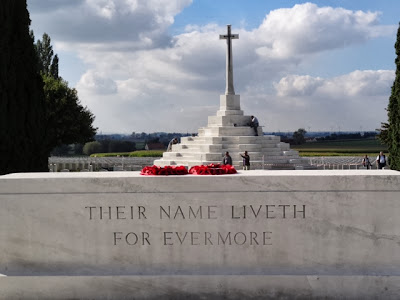I'm standing in the Essex Farm Cemetery in Belgium and I've been asked by our guide to read out John McCrae's "In Flanders Fields" to our small group exploring the region's World War I legacy.
I have read the poem before, but not in the presence of so many of the living and the dead.
It's hard not to be moved by Flanders' fields, the region around the town of Ieper. You can't move far without coming across a cemetery, memorial or reminder of the hundreds of thousands who lost their lives here between 1914 and 1918.
As our guide Roger tells us, it is the most heavily bombed and mined piece of land in the world.
During World War I, the Allies and Germany fought continuously here, but made little ground despite the huge losses and casualties. In the process, they completely leveled all buildings, towns and trees, leaving only a muddy and desolate wasteland.
The scale of the war is sometimes hard to fathom because of the staggeringly high death toll. However, it is some of the individual stories that highlight the war's true impact: two brothers who are buried side by side after being killed on the same day, and the soldier who died aged 15 years.
Just like other World War I battlefields, the trench warfare here was muddy, cold and brutal, complete with poison gas, machine guns, bayonets and barbed wire.
Today, the fields look idyllic under autumn sunshine, but upon further inspection you can still see the scars.
Underground tunnels that once housed soldiers have collapsed, creating ponds for grazing cattle, while the uneven ground in some fields tells of bomb craters. As we pass through a new industrial estate, next to the road lies a rusty, uneploded shell thrown up by excavation.
It seems the fields around here are still revealing their wartime secrets. In the 1990s, building work revealed an extensive dugout and tunnel network along with more than 200 bodies.
The nearby Langemark German Cemetery is a reminder that both sides suffered severe casualties. Its dark and sombre tone is a stark contrast to the bright, white memorials of the Commonwealth War Commission.
Interestingly, while Belgium donated cemetery land to the Commonwealth after the war, it only "leased" cemetery land to Germany.
There are more than 170 cemeteries and memorials in the region, with the Canadian memorial, the Brooding Soldier, perhaps one of the most powerful. Not many memorials have used human figures, but this one of a reflective soldier seems to echo the sense of loss and futility.
The largest Commonwealth cemetery, not just in the region but in the world for any war, is Tyne Cot, on Passchendaele Ridge where one of the most memorable battles was held. Here lie the bodies of about 12,000 soldiers.
Along Tyne Cot's back wall are the names of those soldiers who died but whose bodies were never identified. This is a continuation of the extensive list that starts on the walls of Ieper's Menin Gate, where the Last Post is played at 8pm every night,
More than 185,000 soldiers from Commonwealth countries died in the region, with about 100,000 of these having no known grave.
While Winston Churchill was keen to leave the desolated town of Ieper in ruins as a memorial, not surprisingly the locals wanted to rebuild their town the way it was.
Today the massive Cloth Hall in the middle of town looks in mint condition, with a few bullet holes in the single wall that was left standing after the war the only reminder of its troubled past.
Inside is In Flanders Fields Musuem, which gives an excellent account of the war that not only affected Ieper, but the entire world.
It tells the stories of those who died, and also those who survived with horrific injuries to their face, bodies and minds.
Much has been written about World War I, but it's hard to beat McCrae's reflection.
His account of how poppies sprung up around the soldiers' graves spurred the tradition of wearing a poppy as a sign of remembrance.
Initially McCrae discarded his poem, but it was recovered by a colleague and submitted for publication.
Because of the third stanza it was used in war propoganda, and debate has continued as to whether it is pro-war or anti-war.
But perhaps that's up to each reader to contemplate.


















It is amazing how calm and serene the area is now when you think about all that has happened. Its is a very overwhelming sensation. Pictures really capture your thoughts Matthew.
ReplyDeleteMushy